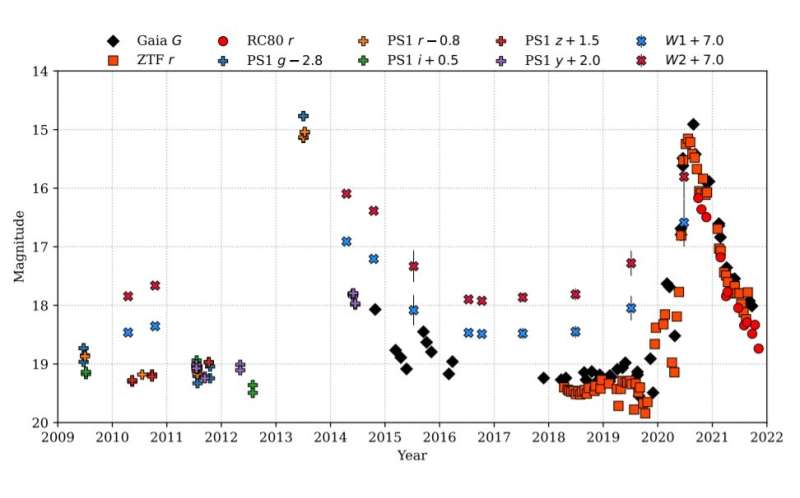
European astronomers have observed a source on the sky known as Gaia20eae, which recently entered a phase of significant outbursting activity. Results of the new study suggest that this source may be an EXor-type eruptive young star. The finding was detailed in a paper published December 8 on the arXiv pre-print server.
Young stellar objects (YSOs) are stars in early stages of evolution, in particular, protostars and pre-main sequence stars. They are usually observed embedded in dense molecular clumps, environments containing plenty of molecular gas and interstellar dust.
Given that episodic accretion processes occur in YSOs, these objects may experience accretion-driven outbursts. In general, the eruptive YSOs are classified as FU Orionis-type objects (FUors) or EX Lupi-type objects (EXors). FUors brighten by more than magnitude 4 in the optical domain and remain in their brightened state for several decades. EXors also brighten by a few magnitudes, but unlike FUors, they remain in the high brightness stage for a few months to a few years.
Now, a team of astronomers led by Fernando Cruz-Saenz de Miera of Konkoly Observatory in Budapest, Hungary, presents evidence indicating that Gaia20eae—a source located some 9,200 light years away, identified in August 2020 by ESA's Gaia satellite—may be another example of an EXor YSO.
The researchers started to monitor Gaia20eae at the beginning of September 2020 and also analyzed the archival data for this source. They found that brightening began in early 2020 and, although it showed certain variability, it increased with an average rate of 0.5 mag per month between January and July 2020.
The currently active brightening peaked in late 2020 July and Gaia20eae is currently quickly fading at a rate of 0.25 mag per month. The astronomers predict that the source should reach its quiescence level in May 2022.
Although the spectral energy distribution (SED) in the quiescence period of Gaia20eae (before the outburst that started in 2020) suggests that it is a Class II YSO (with near-infrared and mid-infrared excess), its near-infrared spectra exhibit several emission lines, what is typical of EXor-type eruptive young stars.
Moreover, the team found that the mass accretion rate for Gaia20eae during its dimming phase is higher than typical T Tauri stars of similar mass, but it is comparable to other known EXors. They added Gaia20eae could have reach mass accretion rates as high as some FUors.
In concluding remarks, the astronomers noted that their findings favor the hypothesis that Gaia20eae is an EXor-type eruptive young star. However, they added that further observations are required in order to draw final conclusions.
"A post-outburst spectrum with lower mass accretion rates would confirm our conclusion. Another outburst detected in 2027 would indicate that the brightenings are periodic and could point towards Gaia20eae not being an EXor," the authors of the paper wrote.
Explore further
© 2021 Science X Network
Citation: Gaia20eae may be an EXor-type star, study finds (2021, December 20) retrieved 20 December 2021 from https://ift.tt/3ebVAT6
This document is subject to copyright. Apart from any fair dealing for the purpose of private study or research, no part may be reproduced without the written permission. The content is provided for information purposes only.
"type" - Google News
December 20, 2021 at 10:53PM
https://ift.tt/3ebVAT6
Gaia20eae may be an EXor-type star, study finds - Phys.org
"type" - Google News
https://ift.tt/2WhN8Zg
https://ift.tt/2YrjQdq
Bagikan Berita Ini














0 Response to "Gaia20eae may be an EXor-type star, study finds - Phys.org"
Post a Comment